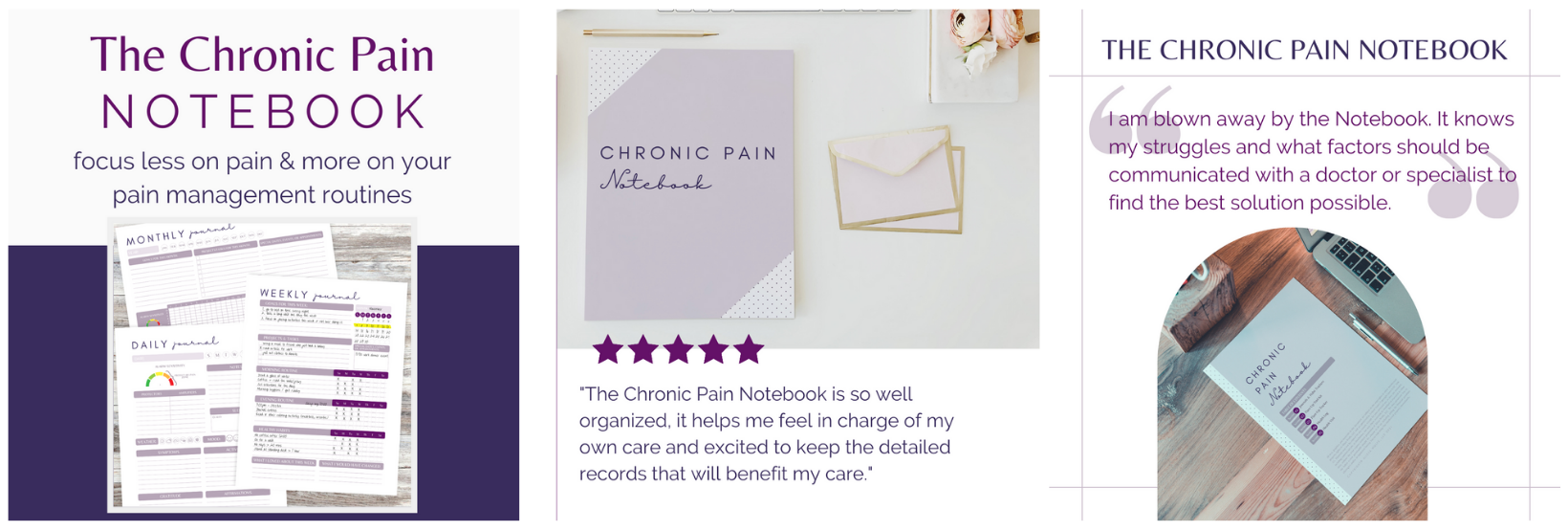10 Things To Include In Your Pain Journal

Life with chronic pain is unpredictable.
One second you're doing okay and the next you can't think because you're in pain up to your eyeballs. What's worse is not knowing what caused the pain this time.
When pain flares up without warning, you're left wondering, "What did I do wrong?" And not knowing what it was can make you even more cautious and afraid to schedule activities for fear the pain will get worse. That's no way to live!
You need to be able to confidently identify what triggers your pain so you can understand how to work around those triggers and respond to pain flares more appropriately.
Using a journal can not only help you identify patterns in your pain, it can also help you stay more consistent with your routines and healthy habits, which can all lead to being better able to control your pain and feeling more confident about scheduling events and activities with your loved ones.
Journaling can be a very useful tool as part of your pain management toolbox but you don't need to be a good writer or have good handwriting to use a pain journal. You don't even need to write in complete sentences!
Using a pain journal shouldn't feel like a chore. A quick 2 minute journal entry can be very powerful. And using a template for your journal entries can be really helpful to make this process as quick and smooth as possible.
So, let's go over a few things to consider including in your journal.
10 things to include in your pain journal:
1. Goals for the week and for the month
Create a space to write down any goals you have for the day, week, or month so you can stay focus on the big picture. Each day, reflect back on your weekly and monthly goals so you can keep the ball moving down the field to the goal.
2. Habit trackers for your routines and healthy habits
Your journal could include a space where you can list and then check off the healthy habits, routines, and pain management drills & strategies you aim to practice consistently.
3. A space for gratitude and affirmations
A daily gratitude practice can improve overall well-being as it helps you to recognize all the things that you are grateful for in your life, no matter how small they may seem. Writing down positive affirmations in your journal can you overcome negative thoughts and beliefs.
4. Weather
Tracking the weather may help you see if there is a relationship between weather and your pain. Recognizing these trends can help you plan for days where your pain might be worse due to changes in the weather.
5. Activities you did that day
Keeping track of the big physical activities (and mental tasks) you performed each day, such as a long walk through the airport, 4 loads of laundry, or pulling weeds can be helpful to figure out your physical limits so you don't have to keep over doing it and causing more unpredictable pain flares.
6. Things you did or used to treat pain
It's a good idea to list what methods you used to manage your pain or other symptoms, whether that was taking medications or supplements, or doing various therapies, or modalities, drills or strategies. This way you will begin to figure out which pain management tools are most effective for you.
7. List of factors you encountered that day that amplify pain or stress
Listing other factors, besides the weather or daily activities, is important to help you understand what things cause your pain to worsen. It may be challenging to identify what these factors are at first, so in the beginning you should include as many things you can think of. For example, you may list things like eating dairy or gluten, drinking alcohol or caffeine, wearing uncomfortable shoes, arguing with your spouse, or hearing bad news. The more you can list the better and over time you will get better at recognizing which ones are actually triggers.
8. A space to track certain metrics (such as your energy level, stress level, activity tolerance, mood, and sleep quality & quantity).
You may want to track certain health metrics using an objective value (such as a scale from 0-10 or by rating it as moderate, fair, or poor). I recommend tracking your metrics visually on a monthly scale if possible, which will help you see trends over time. You can also see if there are relationships between your pain and these metrics. For example, you may notice you have more pain the days after you get poor sleep or on days your stress level is high.
9. Unusual symptoms experienced that day
It can be helpful to write down if you experience any unusual symptoms that are out of the ordinary for you. It's excessive to write down all the symptoms you experience on a daily basis. So if your usual symptoms haven't changed, don't write them down every day. Only write down unusual symptoms that pop up.
10. Alarm sensitivity instead of pain intensity
I actually don't recommend recording pain in your journal. The less you focus on pain the better. The more you tune in to pain - the more you focus on it, think about it, dwell on it - the worse it tends to get.
Additionally, using the 0-10 pain scale is a very unreliable tool. In my opinion, the only time we should be using the 0-10 pain scale is when we are required rate or pain level at the doctors office. I recommend ditching the pain scale all together in your personal life. What I like to track instead is overall "alarm sensitivity".

Chronic pain is associated with a hypersensitive nervous system but the sensitivity of the nervous system does fluctuate. We call the sensitivity of the nervous system at any given moment it's "alarm sensitivity". When alarm sensitivity is low, things are relatively good, and it takes a larger stimulus to generate pain. When alarm sensitivity is high, it takes a smaller stimulus to cause pain to worsen.
I recommend recording alarm sensitivity in your journal using a little diagram that looks like a speedometer.
........................

Now, you certainly do not need to include everything mentioned in the above list in your daily journal entries. I recommend choosing the ones that are the most relevant to you or matter the most to you.
Remember, the goal is to make it quick and easy. The more energy this requires, the less likely you are to stick to doing your daily journal entries.
Put your journal and your favorite pen in an obvious location where you're more likely to see it. And then try to keep your daily journal entry practice to 2 minutes by using bullet points and a template. You can create a template of your own or you can use my premade template.
My Chronic Pain Notebook includes template pages you can easily print out for daily journal entries, weekly journal entries, and monthly journal entries. It's designed to help you focus less on your pain and more on your pain management routine. And it includes other sections that will help you manage flare-ups and make your doctor visits go more smoothly. Download the Chronic Pain Notebook Here.
Get Pain Articles & Neuroscience Nuggets Sent To Your Inbox.
Subscribe to my Blog!







